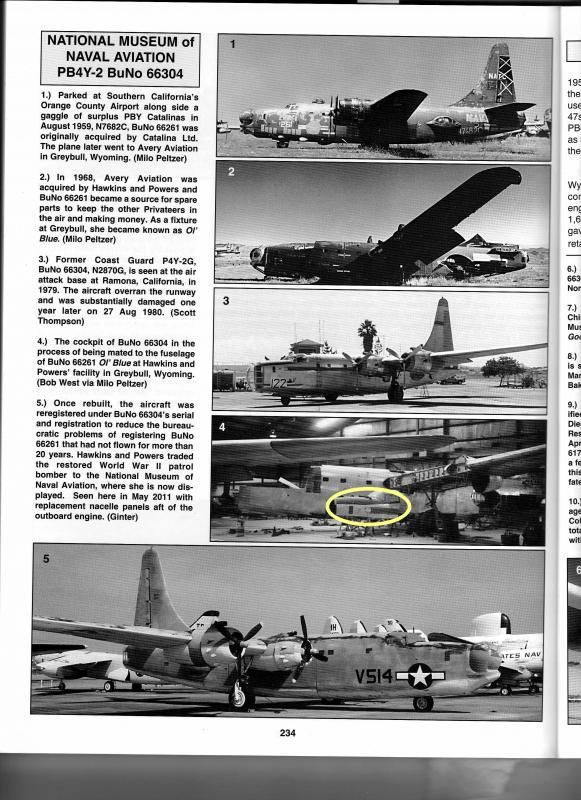For you folks that track this stuff and haven't seen it yet.....I got this in the inbox today and figured I'd put it out there.

Quote:
As probably know, the former USCG P4Y-2G (ex-USN PB4Y-2S, BUNO 66304) is on display at the Naval Aviation Museum,
now preserved in late WWII livery less upper turrets. Well, the Navy does run the place and they can pretty well do what they
want as it's their paint and paint shop. BUT, there is a twisted history behind this aircraft as presently displayed.
HISTORY: BUNO 66304 (CG #6304)
66304 (Consolidated Vultee c/n 720) was delivered to the USN and saw very limited service winding up in desert storage
until it was reactivated for duty with the USCG. After basic airframe modification that included removing all gun turrets and
various electronic equipment, weight & balance calculations were recalculated and documented. CG6304 entered USCG
service on December 11, 1952, with its primary area of operating area within the vast Pacific area with operational basing
primarily at SFO or Hawaii. This aircraft left USCG service on July 1, 1958, and commenced an operational career as a
fire retardant under U.S. Civil Registration as N2870G. In its new life, the original R-1830 engines were replaced with the
R-2600 series engines that had originally powered the B-25 series aircraft. While operating as in its civilian category, the
aircraft suffered substantial damage on August 27, 1980, when, after landing, it ran off the end of the runway. Due to
the damaged it received, it was rendered un-flyable and parked. Many useable parts were removed and used to keep
other fire tanker airframes in the Hawkins & Powers company fleet earning money. Enter BUNO 66261
BUNO 66261 [no USCG service]
66261 (CONVAIR c/n 677) was delivered to the USN and saw operational service with the Navy before being declared
surplus and sold on civil the market and registered as N7682C. As such, its primary mission was as a spare parts source for
its various owners until Hawkins & Powers decided to use it as a major source to build another P4Y-2 airframe. As N7682C
had never flown or operated under its N-number and a very small portion of 66304, also containing the Consolidated aircraft
I.D. plate, was added to the bulk of 66261 to complete a P4Y-2 fuselage. Once blended, the re-worked airframe was re-
registered as N2870G was issued a certificate of airworthiness as the original 66304, c/n 720. Enter V514....
BUNO 59514 (aka: bow number V514)
With the donation of 66304/66261, the museum opted to display the combined airframes as PB4Y-2, 59514, in the markings
of PARTOL BOMBING SQUADRON 109 (VPB-109) as the original 514 operated in the WESTPAC area during late WWII.
Well, they do own the paint shop.....!
The point of the forgoing is the fact that the combined airframes operated within the National Airspace System and under
existing FARs with the FAA being none the wiser. Of course, there have been other cases - - - - - -
On June 2, 1983, Canadian registered (CF-TLU), a Douglas model DC-9-32, c/n 47196, experienced an in-flight cabin fire and
landed at CVG where the fire consumed the entire fuselage. The aircraft was listed as destroyed and its remains were released
to the insurance company at the completion of the investigation.
On December 20, 1983, U.S. Registered N994Z, a Douglas model DC-9-30, c/n 47097, collided with a snow sweeper upon landing
at FSD. The collision caused the left wing to separate from the aircraft immediately outboard of the left main gear assembly. The
aircraft suffered additional damage due to careening sideways to the runway direction until it finally came to a stop. The aircraft
was officially listed as destroyed and was released to the insurance company at the completion of the investigation.
In 1985, as the result of an incident involving a Northwest Airlines DC-9, the NTSB, during the course of that investigation, learned
that NWA was operating a DC-9 that consisted of the fuselage of N994Z and the wings of CF-TLU, under the Douglas c/n 47097.
This aircraft had been operating with a very questionable COA and the aircraft was immediately removed from revenue service.
It was the only known model of the DC-9-31.5 ever....and the only known Part 121 homebuilt............
See the attached for supporting P4Y-2 data. The area outlined in yellow was all that was left of 66304 and is shown just prior to
being mated with 66261.





